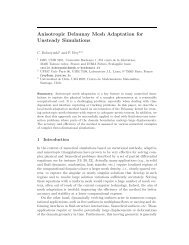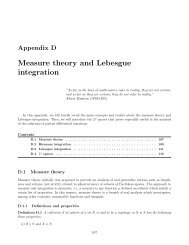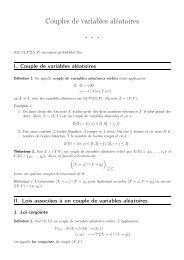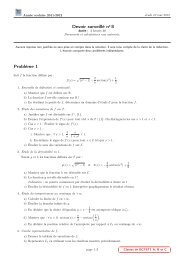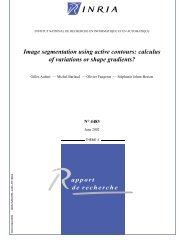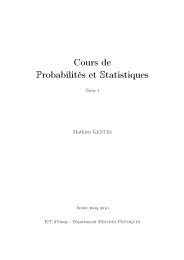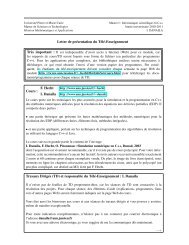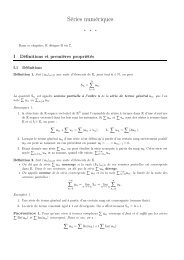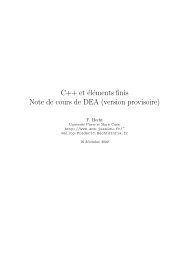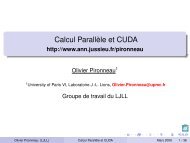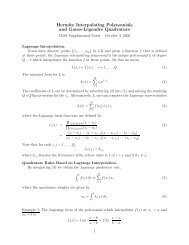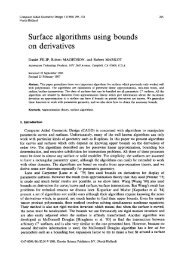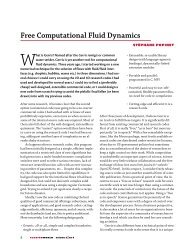pdf file
pdf file
pdf file
Create successful ePaper yourself
Turn your PDF publications into a flip-book with our unique Google optimized e-Paper software.
18 M. LEWIN, P. T. NAM, S. SERFATY, AND J. P. SOLOVEJ<br />
Lemma 4 (Strong condensation of bosonic atoms). If t ≤ tc, then<br />
�<br />
Ht,N −NeH ≥ 1−N −2/3� �N<br />
(ht)i −CN 1/3 . (31)<br />
Remark 8. In particular, from (31) it follows that if 〈Ht,N〉Ψ ≤ NeH +R,<br />
then 〈u0,γΨu0〉 ≥ N − CN 1/3 which is (A3). When t < tc, by Theorem 2<br />
we can improve the estimate to 〈u0,γΨu0〉 ≥ N −C. The latter was shown<br />
by Bach, Lewis, Lieb and Siedentop in [4] using a different method.<br />
Proof. We start by estimating the terms on the right side of the Lieb-Oxford<br />
inequality (30). First, from the positivity D(f,f) ≥ 0, we have<br />
1<br />
2 D(ρΨ,ρΨ) ≥ D(ρΨ,N|ut| 2 )− 1<br />
2 D(N|ut| 2 ,N|ut| 2 )<br />
= ND(ρΨ,|ut| 2 )+N 2 (eH(t)−µH(t)). (32)<br />
Ontheotherhand,usingtheHoffmann-Ostenhofinequality[29]andSobolev’s<br />
inequality [36, Theorem 8.3] we can estimate<br />
� �<br />
N�<br />
� �<br />
Ψ, −∆i Ψ = Tr[−∆γΨ] ≥ 〈 √ ρΨ,−∆ √ �� �1/3 ρΨ〉 ≥ C .<br />
i=1<br />
i=1<br />
R3 ρ 3 Ψ<br />
Therefore, by Hölder inequality, we find that<br />
�<br />
ρ 4/3<br />
Ψ ≤<br />
��<br />
ρ 3 �1/6�� �5/6 Ψ ρΨ ≤ εTr[−∆γΨ]+C N5/3<br />
.<br />
ε<br />
Thus using the Lieb-Oxford inequality (30), the estimate (32) and ht ≥<br />
−∆/2−C we get<br />
�<br />
〈Ht,N〉Ψ ≥ NeH(t)+ 1− 2ε<br />
�<br />
Tr[htγΨ]−2Cε−Cε<br />
N<br />
−1 N 2/3<br />
for all ε > 0. Replacing ε by N 1/3 /2, we obtain (31). �<br />
All this shows that if t < tc, then Assumptions (A1)-(A2)-(A3s) hold<br />
true, and we may apply Theorem 2 to show that the lower spectrum of Ht,Z<br />
converges to the lower spectrum of the Bogoliubov Hamiltonian<br />
�<br />
Ht := a ∗ (x) � (ht +Kt)a � (x)dx<br />
Ω<br />
+ 1<br />
2<br />
�<br />
Ω<br />
�<br />
Ω<br />
�<br />
Kt(x,y)<br />
which acts on the Fock space F+ = � ∞<br />
n=0<br />
a ∗ (x)a ∗ (y)+a(x)a(y)<br />
�<br />
dxdy,<br />
� n<br />
sym H+. Beside some basic<br />
propertiesofHt alreadygiven inTheorem1, wehavethefollowingadditional<br />
information.<br />
Proposition 5 (Bogoliubov Hamiltonian of bosonic atoms). For every t ∈<br />
(0,tc) one has<br />
σess(Ht) = [infσ(Ht)−µH(t),∞).<br />
Moreover, if t < 1, then Ht has infinitely many eigenvalues below its essential<br />
spectrum. On the other hand, if t ≥ 1, then Ht only has finitely many<br />
eigenvalues below its essential spectrum.



